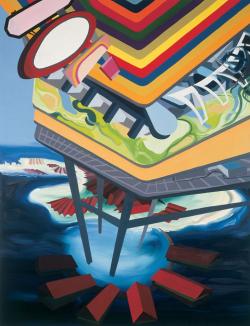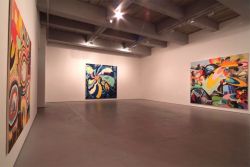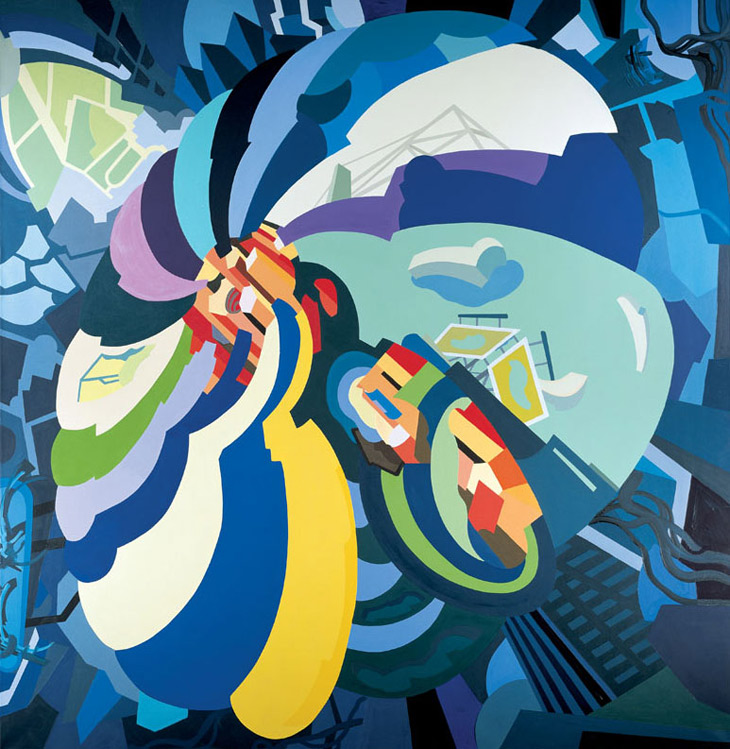
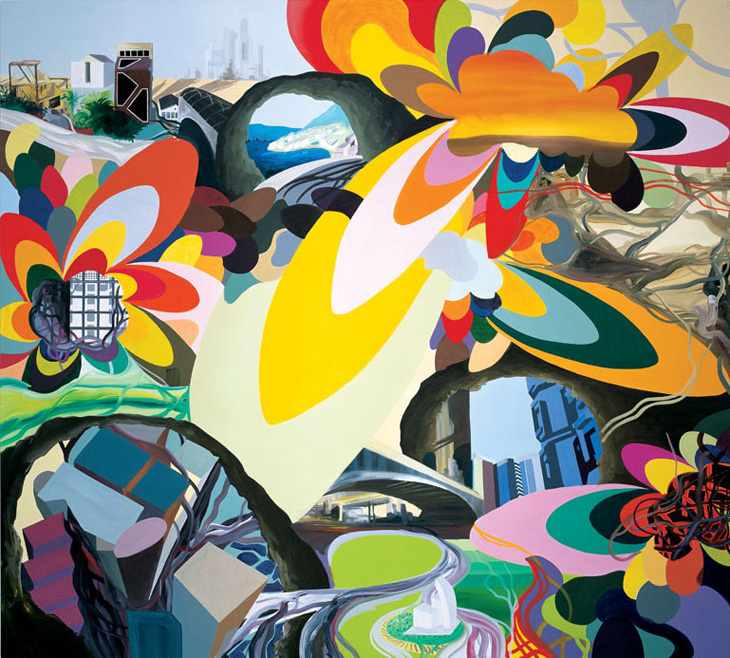
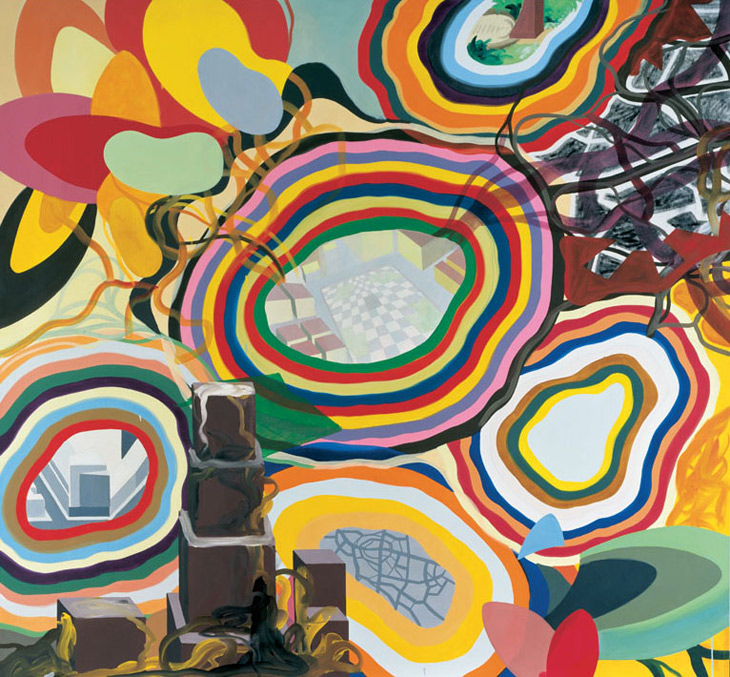

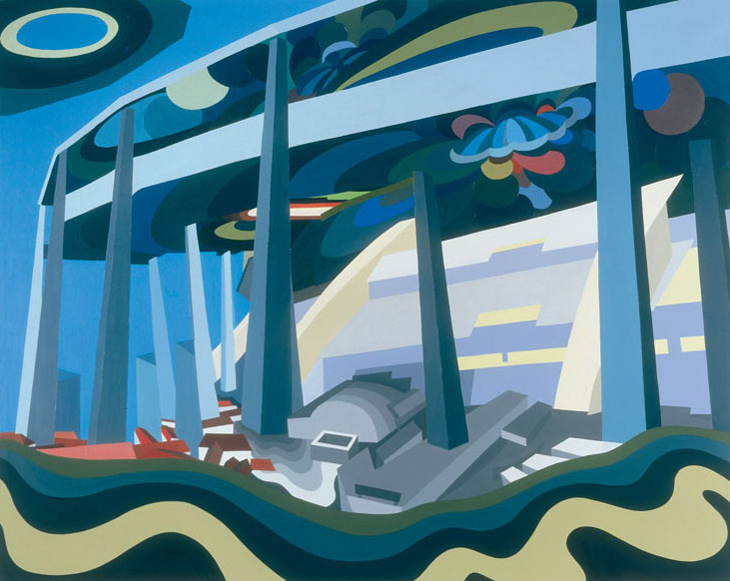


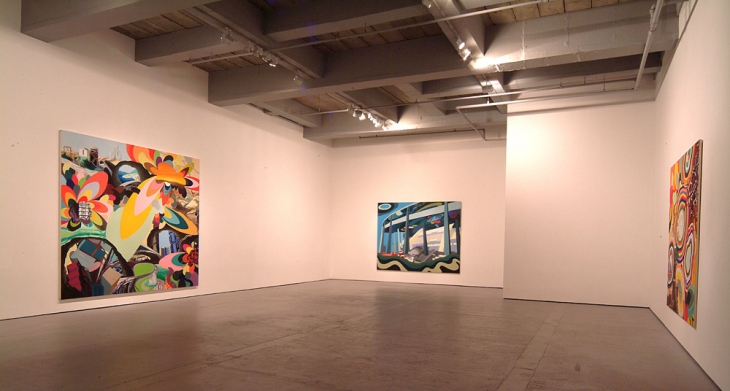
ARTIST:
Franz Ackermann
In Helicopter, Ackermann presents a gyrating distortion. Glimpsed from above, his ‘map’ is more graphic than topographical: any sense of real space has been compressed to the flatness of a logo. Among the steely refined greys of a mountainside reclusion are the stripy steppes of a vineyard and a plastic sunset. It’s only the ‘flat-pack’ patio furniture that suggests a luxury villa and not just the abstraction of affluence.
In Mental Map: Evasion V, Ackermann creates a biotic abstraction, a template for natural phenomena dictated by design. His jumbled composition is harmonious in its turmoil: concentric patterns of colour expose hints of identifiable place (a street map, a building interior, a snippet of landscape) only to dislocate them in a maze of organic generalisations.
Constructed graphics are corroded, integrated as if by evolution, to incorporate somatic qualities: sublime contemplation is achieved only through artificial enhancement. Evasion VI is less a representation of a specific place than an eruption of global confusion. Wild blasts of colour rip tangled organic masses apart. Amid the wreckage are tiny vignettes of landscape displaced from their natural setting. Ackermann’s painting has an undertone of catastrophe: desert sunsets, rocky coves, and industrial parks clash together like tectonic plates in an ethical snafu. Through his unbridled abstraction, Ackermann strives to chart out the physical impossibility of conceptual space. Evasion VI reconstructs our chaotic perception of the world as an apocalyptic image-byte. Ackermann paints New Building as a package holiday resort spiralling out of control. Destination: doesn’t matter. This exact development could be found anywhere. His warped perspective and candy-coloured banners compose an off-kilter composition, both unsettling and jubilant.
A triumph of marketing over nature, his hard-edged abstraction springs like Poseidon’s gift from the sea: the new universal symbol for ‘beach’. Ackermann is a perpetual tourist: his paintings are like large trippy postcards from the edge. Dealing with globalisation and the commodification of cultural landscape, his work is representative of an ever-shrinking world.
Referring to his images as ‘mental maps’, Ackermann readily digests the subtle nuances of popular destinations
and regurgitates them as international signifiers: brightly coloured shapes, high-impact graphics, and pop iconography. Ackermann’s cityscape is information overload: a seething metropolis striated in Technicolor glory. Grey modernist architecture looms at an unnatural angle, engulfed in retro-style smog, while an inverted stairway to heaven descends into the open earth below. Ackermann paints his underworld as a spacey utopia: fiery blobs of magma swell with hypnotic seduction, revealing a virgin landscape at their core. The Secret Tunnel
is not a paradise, but an upper and middle earth equally and oppositely attractive.
Constructed graphics are corroded, integrated as if by evolution, to incorporate somatic qualities: sublime contemplation is achieved only through artificial enhancement. Evasion VI is less a representation of a specific place than an eruption of global confusion. Wild blasts of colour rip tangled organic masses apart. Amid the wreckage are tiny vignettes of landscape displaced from their natural setting. Ackermann’s painting has an undertone of catastrophe: desert sunsets, rocky coves, and industrial parks clash together like tectonic plates in an ethical snafu. Through his unbridled abstraction, Ackermann strives to chart out the physical impossibility of conceptual space. Evasion VI reconstructs our chaotic perception of the world as an apocalyptic image-byte. Ackermann paints New Building as a package holiday resort spiralling out of control. Destination: doesn’t matter. This exact development could be found anywhere. His warped perspective and candy-coloured banners compose an off-kilter composition, both unsettling and jubilant.
A triumph of marketing over nature, his hard-edged abstraction springs like Poseidon’s gift from the sea: the new universal symbol for ‘beach’. Ackermann is a perpetual tourist: his paintings are like large trippy postcards from the edge. Dealing with globalisation and the commodification of cultural landscape, his work is representative of an ever-shrinking world.
Referring to his images as ‘mental maps’, Ackermann readily digests the subtle nuances of popular destinations
and regurgitates them as international signifiers: brightly coloured shapes, high-impact graphics, and pop iconography. Ackermann’s cityscape is information overload: a seething metropolis striated in Technicolor glory. Grey modernist architecture looms at an unnatural angle, engulfed in retro-style smog, while an inverted stairway to heaven descends into the open earth below. Ackermann paints his underworld as a spacey utopia: fiery blobs of magma swell with hypnotic seduction, revealing a virgin landscape at their core. The Secret Tunnel
is not a paradise, but an upper and middle earth equally and oppositely attractive.



